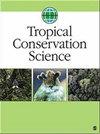Current State of Knowledge of Páramo Amphibians in Colombia: Spatio Temporal Trends and Information Gaps to Be Strengthened for Effective Conservation
IF 1.6
4区 环境科学与生态学
Q2 BIODIVERSITY CONSERVATION
引用次数: 0
Abstract
Background and Research Aims: Globally, Colombia is the country with the largest extent of Páramos (delimited in 36 complexes) and with the greatest number of amphibian species in this ecosystem. This work consolidated scientific literature on the amphibians of the Colombian Páramos to characterize temporal, taxonomic, thematic, and geographic patterns, which allow us to identify information gaps that must be fulfilled to achieve effective species conservation. Methods: We conducted a systematic literature survey with seven different search strategies and generated a database. We read each document's Abstract, Methods, Study Area, Results, and supplementary material, following the PRISMA (Preferred Reporting Items for Systematic reviews and Meta-Analyses) protocol. Results: We found 405 documents published between 1863 and 2021. The composition and richness of 142 amphibian species (95 endemics to Colombia), presented significant differences in Páramo complexes and between sectors. Since 2000, the diversity of research topics has increased with a high proportion of studies on Natural History, Systematics and Taxonomy, and Conservation, distributed between 19 and 22 of the departments with Páramos in their jurisdiction. However, much of this knowledge concentrates in less than 20% of total species in just 6% of Páramos complexes. Conclusion: We found critical shortfalls in taxonomy, spatial information, and conservation actions on Páramos amphibians. We need to increase studies that include field data in more geographic areas and research topics, such as Population and Community ecology, Natural history (from a quantitative approach), Infectious disease, and Ecophysiology. Implications for Conservation: The scientific information gaps represent a challenge in generating effective strategies to conserve Páramo amphibians, considering the high degree of endemism and threats to these species. More than 80% of the Páramo amphibian species only have the information of their descriptions and little is known about their ecological requirements, population size, or data related to specific threats.哥伦比亚Páramo两栖动物的知识现状:为了有效保护,需要加强时空趋势和信息差距
背景和研究目标:在全球范围内,哥伦比亚是Páramos分布范围最大的国家(分为36个综合体),也是该生态系统中两栖动物物种数量最多的国家。这项工作整合了关于哥伦比亚帕拉莫斯两栖动物的科学文献,以描述时间、分类学、专题和地理模式,使我们能够确定必须填补的信息空白,以实现有效的物种保护。方法:我们采用七种不同的搜索策略进行了系统的文献调查,并生成了一个数据库。我们按照PRISMA(系统评价和荟萃分析的首选报告项目)方案阅读了每份文件的摘要、方法、研究领域、结果和补充材料。结果:我们发现了在1863年至2021年间发表的405篇文献。142种两栖动物(95种哥伦比亚特有种)的组成和丰富度在帕拉莫复合体和各部门之间存在显著差异。自2000年以来,研究主题的多样性有所增加,自然史、系统学和分类学以及保护研究的比例很高,分布在其管辖范围内有Páramos的19至22个部门之间。然而,这些知识大多集中在Páramos复合体中不到20%的总物种中。结论:我们发现Páramos两栖动物在分类学、空间信息和保护行动方面存在严重不足。我们需要增加研究,包括更多地理区域和研究主题的实地数据,如人口和社区生态学、自然史(从定量方法来看)、传染病和生态生理学。对保护的影响:考虑到Páramo两栖动物的高度特有性和威胁,科学信息差距在制定有效的保护策略方面是一个挑战。超过80%的Páramo两栖动物物种只有其描述的信息,对其生态要求、种群规模或与特定威胁相关的数据知之甚少。
本文章由计算机程序翻译,如有差异,请以英文原文为准。
求助全文
约1分钟内获得全文
求助全文
来源期刊

Tropical Conservation Science
BIODIVERSITY CONSERVATION-
CiteScore
3.60
自引率
5.90%
发文量
16
审稿时长
>12 weeks
期刊介绍:
Tropical Conservation Science is a peer-reviewed, open access journal that publishes original research papers and state-of-the-art reviews of broad interest to the field of conservation of tropical forests and of other tropical ecosystems.
 求助内容:
求助内容: 应助结果提醒方式:
应助结果提醒方式:


